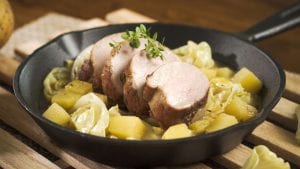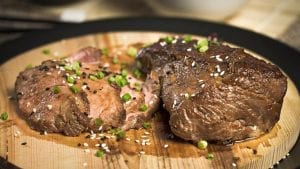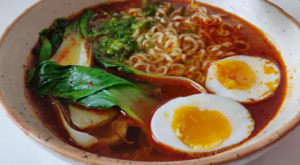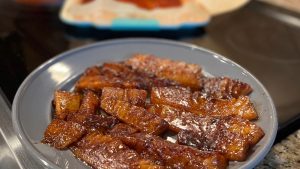Looking for a savory and decadent dish to impress your dinner guests? Look no further than this mouthwatering Pork Tenderloin, served with a luscious Burgundy Peppercorn Sauce. The tender, succulent pork is complemented perfectly by the bold, rich flavors of the sauce, creating a meal that's sure to be a hit.
Photos of Pork Tenderloin with Burgundy Peppercorn Sauce Recipe
Some ingredients like fresh shallots, freshly-cracked black peppercorns, and heavy cream may not be readily available in your kitchen pantry. Head over to your local supermarket to find these. Fresh shallots will give a sweet and mild flavor, freshly-cracked black peppercorns give a much more vibrant flavor than pre-cracked ones, and heavy cream is essential in creating a rich and creamy sauce.
Ingredients for Pork Tenderloin with Burgundy Peppercorn Sauce
Pork tenderloin: A lean, tender cut of meat. It's the meat of choice for this recipe due to its tenderness and mild flavor.
Olive oil: Used for browning the tenderloin and sautéing the shallots and garlic.
Shallots: They add a sweet, mild flavor to the dish.
Garlic: Gives a robust flavor to the sauce.
Black peppercorns: Freshly cracked for a vibrant, spicy note.
Red wine: Adds depth and complexity to the sauce. Choose a good quality one.
Beef broth: The base for the sauce, it adds rich, meaty notes.
Heavy cream: Gives the sauce its creamy, velvety texture.
Parsley: Adds a touch of freshness to balance out the richness of the dish.
One reader, Fran Kidd says:





This pork tenderloin with burgundy peppercorn sauce recipe is a game-changer! The tenderloin was perfectly juicy and the sauce was a delightful burst of flavors. It's a must-try for anyone who loves a gourmet meal without the hassle. I highly recommend it for a special dinner.
Techniques Required for Making Pork Tenderloin with Burgundy Peppercorn Sauce
How to prepare the pork tenderloin: Preheat the oven to 425 degrees F. Trim the pork tenderloin and remove any excess fat and silver skin.
How to cook the pork tenderloin: Heat 1 tablespoon of olive oil in a large skillet over medium-high heat. Generously season the tenderloin with the freshly-cracked black pepper and press to ensure it sticks. Cook the tenderloin for about 4 to 5 minutes, turning as needed, until evenly browned.
How to roast the pork tenderloin: Transfer the browned tenderloin to a greased baking dish and place it in the preheated oven. Roast for about 12 to 15 minutes, or until an instant-read thermometer inserted into the thickest part of the tenderloin reads 140 degrees F.
How to make the burgundy peppercorn sauce: In a skillet or saucepan over medium-high heat, add the shallots and sauté for about 2 minutes. Then add the garlic and sauté for 1 more minute.
How to deglaze the pan: Add the red wine and, as it boils, deglaze the pan by scraping the bottom with a wooden spoon to dislodge all the browned bits.
How to reduce the sauce: Once the wine is almost cooked away, add the beef stock and turn the heat to high. Boil the sauce down for about 4 to 5 minutes until there’s a noticeable trail when you drag a wooden spoon through the center of it.
How to finish the sauce: Pour in the heavy cream and resume boiling. Boil down until you can make that telltale trail from the wooden spoon. Turn off the heat and add the parsley and any remaining black pepper. Taste for salt and add if needed.
How to assemble the dish: Cut the tenderloin into slices and spoon the sauce over it to serve.
How To Make Pork Tenderloin with Burgundy Peppercorn Sauce
What makes this pork tenderloin an amazing dish is burgundy peppercorn sauce – a tasty mix of onions, garlic, wine, beef stock, parsley, and black pepper.
Serves:
Ingredients
- 1lbpork tenderloin
- 2tbspolive oil,(separated)
- 1cupfinely chopped shallots,or onion
- 3garlic cloves,minced
- ¼: 5px; letter-spacing: 2px”>½cupred wine
- 2cupsbeef broth
- ½cupheavy cream
- ½cupparsley
Instructions
To Prepare the Tenderloin:
-
Preheat oven to 425 degrees F. Trim pork tenderloin of any excess fat, and remove silver skin.
-
Heat 1 tablespoon of olive oil in a large skillet over medium-high heat. Generously season the tenderloin with the freshly-cracked black pepper, and press to be sure it sticks.
-
Add to the skillet and cook, turning as needed, for about 4 to 5 minutes (about 1 minute per side), until evenly browned.
-
Transfer tenderloin to a greased baking dish, and place it in the oven to roast for about 12 to 15 minutes, until an instant-read thermometer inserted into the thickest part of the tenderloin reads 140 degrees F.
-
Remove the dish from the oven and transfer the tenderloin to a plate and cover loosely with aluminum foil to keep warm.
To Make the Burgundy Peppercorn Sauce:
-
Meanwhile, in a skillet or saucepan over medium-high heat, add the shallots and sauté for about 2 minutes. Then add the garlic and sauté for 1 more minute.
-
Add the red wine and as it boils, deglaze the pan by scraping the bottom of the pan with a wooden spoon (helps to have one with a straight edge) to dislodge all the browned bits.
-
Once the wine is almost cooked away, add the beef stock and turn the heat to high. Boil the sauce down for about 4 to 5 minutes until there’s a noticeable trail when you drag a wooden spoon through the center of it.
-
Pour in the heavy cream and resume boiling. Again, boil down until you can make that telltale trail from the wooden spoon.
-
Turn off the heat and add the parsley and any remaining black pepper (no more than 1 tablespoon, the rest should have already been used to pepper the tenderloin). Taste for salt and add if needed.
To Assemble the Dish:
-
Cut the tenderloin on a slight diagonal (in ½- or 1-inch slices), and then spoon the sauce over to serve.
Recipe Notes
Feel free to substitute in any other favorite wines, brandy, or cognac in for the red wine on this.
Nutrition
- Calories: 195.57kcal
- Fat: 11.10g
- Saturated Fat: 4.64g
- Trans Fat: 0.02g
- Monounsaturated Fat: 4.89g
- Polyunsaturated Fat: 0.93g
- Carbohydrates: 7.69g
- Fiber: 1.66g
- Sugar: 2.47g
- Protein: 14.25g
- Cholesterol: 57.23mg
- Sodium: 159.97mg
- Calcium: 48.98mg
- Potassium: 501.62mg
- Iron: 1.63mg
- Vitamin A: 77.86µg
- Vitamin C: 7.03mg
Crucial Technique for Perfecting Pork Tenderloin
When preparing the pork tenderloin, it's crucial to remove the silver skin, which is a thin layer of connective tissue. It can be tough when cooked, so for the most tender results, use a sharp knife to carefully trim it off before seasoning and cooking. Additionally, when making the burgundy peppercorn sauce, ensure to properly deglaze the pan with red wine. This process not only adds depth of flavor to the sauce but also allows you to scrape up any delicious browned bits from the bottom of the pan, enhancing the overall taste of the dish.
Time-Saving Tips for Preparing Pork Tenderloin
Prep ahead: Marinate the pork tenderloin the night before to infuse it with flavor and save time on the day of cooking.
Multitask: While the pork is roasting in the oven, use that time to prepare the burgundy peppercorn sauce on the stovetop.
Quality ingredients: Use high-quality pork tenderloin and freshly-cracked black peppercorns for the best flavor in the dish.
Efficient cooking: Use a meat thermometer to ensure the pork tenderloin is cooked to the perfect temperature, preventing overcooking and saving time.
Streamline prep: Chop the shallots and garlic in advance to minimize prep time when making the sauce.
Sauce consistency: Boil down the sauce until it coats the back of a spoon, ensuring a rich and flavorful consistency.
Sharp knife: Use a sharp knife to slice the tenderloin, making it easier and quicker to cut into serving portions.
Taste as you go: Adjust the seasoning of the sauce as needed, tasting as you add ingredients to ensure a balanced flavor profile.
Substitute Ingredients For Pork Tenderloin with Burgundy Peppercorn Sauce Recipe
pork tenderloin - Substitute with chicken breast: Chicken breast is a lean and versatile meat that can be used as a substitute for pork tenderloin. It has a mild flavor and tender texture, making it a suitable alternative in this recipe.
shallots - Substitute with onions: Onions can be used as a substitute for shallots in this recipe. They provide a similar savory and slightly sweet flavor, making them a suitable replacement for shallots.
red wine - Substitute with beef broth and a splash of red wine vinegar: Beef broth combined with a small amount of red wine vinegar can replicate the depth and richness of red wine in the sauce, while also providing a savory flavor.
beef broth - Substitute with vegetable broth: Vegetable broth can be used as a substitute for beef broth to maintain the savory flavor in the recipe while catering to a vegetarian diet or preference.
heavy cream - Substitute with coconut cream: Coconut cream can be used as a dairy-free substitute for heavy cream, adding a rich and creamy texture to the sauce while imparting a subtle coconut flavor.
parsley - Substitute with chives: Chives can be used as a substitute for parsley to provide a mild onion-like flavor and a pop of green color to the dish.
Presentation Tips for Pork Tenderloin with Burgundy Peppercorn Sauce
Elevate the pork tenderloin: Slice the pork tenderloin into even portions and arrange them in a circular or linear pattern on the plate. Ensure that the slices are neatly stacked or fanned out for an elegant presentation.
Artful sauce drizzle: Use a squeeze bottle or a small ladle to create a delicate drizzle of the burgundy peppercorn sauce around the pork tenderloin. Aim for a balanced and artistic distribution of the sauce to enhance the visual appeal of the dish.
Garnish with fresh herbs: Sprinkle a few sprigs of fresh parsley over the pork tenderloin and around the plate. The vibrant green color of the parsley will provide a beautiful contrast and add a touch of freshness to the presentation.
Incorporate color contrast: Consider adding a pop of color to the plate by including a small portion of vibrant vegetables or edible flowers. This will not only enhance the visual appeal but also add a subtle complexity to the overall presentation.
Utilize negative space: Embrace the concept of negative space on the plate to allow the main elements of the dish to stand out. Avoid overcrowding and aim for a balanced composition that highlights the pork tenderloin and the sauce.
Attention to plate cleanliness: Ensure that the rim of the plate is clean and free from any sauce or food smudges. A pristine presentation reflects attention to detail and professionalism.
Consider elegant plating vessels: Select elegant and sophisticated plating vessels that complement the upscale nature of the dish. Opt for minimalist designs or classic dinnerware to showcase the pork tenderloin with burgundy peppercorn sauce.
Essential Kitchen Tools for Making Pork Tenderloin
- Oven: You will need an oven to roast the pork tenderloin at 425 degrees Fahrenheit.
- Skillet: A skillet is used to brown the pork tenderloin and to prepare the burgundy peppercorn sauce.
- Baking dish: A baking dish is used to roast the pork tenderloin in the oven.
- Instant-read thermometer: An instant-read thermometer is used to check the internal temperature of the pork tenderloin to ensure it reaches 140 degrees Fahrenheit.
- Wooden spoon: A wooden spoon is used to deglaze the pan and stir the sauce while cooking.
- Saucepan: A saucepan is used to prepare the burgundy peppercorn sauce.
- Aluminum foil: Aluminum foil is used to cover the cooked pork tenderloin to keep it warm before serving.
Storing and Freezing Pork Tenderloin with Burgundy Peppercorn Sauce
Here are the storing and freezing guidelines for pork tenderloin with burgundy peppercorn sauce:
- Let the cooked pork tenderloin cool completely before storing. Place it in an airtight container or wrap it tightly with plastic wrap or aluminum foil. Store in the refrigerator for up to 3-4 days.
- To freeze the pork tenderloin, wrap it tightly in plastic wrap or aluminum foil, then place it in a freezer-safe container or resealable freezer bag. Label with the date and freeze for up to 2-3 months. Thaw overnight in the refrigerator before reheating.
- For the burgundy peppercorn sauce, let it cool completely, then transfer to an airtight container. Store in the refrigerator for up to 3-4 days.
- To freeze the sauce, pour it into a freezer-safe container or resealable freezer bag, leaving some headspace for expansion. Label with the date and freeze for up to 2-3 months. Thaw overnight in the refrigerator before reheating.
- To reheat the pork tenderloin, wrap it in aluminum foil and place it in a preheated 350°F (175°C) oven for 10-15 minutes, or until heated through. Alternatively, slice the tenderloin and reheat it in a skillet over medium heat until warmed through.
- Reheat the burgundy peppercorn sauce in a saucepan over low heat, stirring occasionally, until heated through. If the sauce appears too thick, add a splash of beef broth or water to thin it out.
How To Reheat Pork Tenderloin Leftovers
Preheat your oven to 350°F (175°C). Place the leftover pork tenderloin in an oven-safe dish and cover it with aluminum foil. Reheat the pork in the oven for about 10-15 minutes, or until it reaches an internal temperature of 165°F (74°C). This method helps to retain the moisture in the meat and prevents it from drying out.
If you have a sous vide machine, you can reheat the pork tenderloin by placing it in a sealed bag and submerging it in a water bath set to 140°F (60°C) for about 30 minutes. This method ensures even reheating and maintains the tenderness of the meat.
For a quick and easy option, you can reheat the pork tenderloin in the microwave. Slice the pork into even pieces and place them in a microwave-safe dish. Cover the dish with a damp paper towel to prevent the meat from drying out. Microwave on high for 1-2 minutes, or until the pork is heated through.
To reheat the burgundy peppercorn sauce, pour it into a saucepan and heat it over low heat, stirring occasionally. If the sauce has thickened, you can add a splash of beef broth or water to thin it out. Be careful not to overheat the sauce, as the heavy cream may separate.
If you want to add a fresh twist to your leftover pork tenderloin, slice it thinly and use it as a filling for sandwiches or wraps. Reheat the sliced pork in a skillet over medium heat with a little bit of olive oil until it's warmed through. Serve the pork on a crusty roll or in a tortilla wrap with your favorite toppings.
Interesting Fact About Pork Tenderloin with Burgundy Peppercorn Sauce
Pork tenderloin is a lean and tender cut of meat that is low in fat and high in protein, making it a healthy choice for a delicious meal.
Is Making Pork Tenderloin at Home Cost-Effective?
The cost-effectiveness of this pork tenderloin with burgundy peppercorn sauce recipe largely depends on the availability and cost of ingredients in your area. Pork tenderloin can be relatively affordable, and the use of red wine and beef broth can add depth of flavor without breaking the bank. However, the use of heavy cream and shallots may increase the overall cost. Considering the average cost for a household of 4 people, this recipe could range from $25 to $35, earning a verdict rating of 7 for its flavor and versatility.
Is Pork Tenderloin with Burgundy Peppercorn Sauce Healthy?
The pork tenderloin with burgundy peppercorn sauce recipe is a delicious and indulgent dish, but it may not be the healthiest option. Here's why:
- The recipe calls for a significant amount of heavy cream, which is high in saturated fat and calories. Consuming too much saturated fat can increase the risk of heart disease and other health issues.
- The sauce also contains a fair amount of red wine and beef broth, which can add extra calories and sodium to the dish.
- While pork tenderloin is a lean cut of meat, the recipe doesn't include many vegetables or other nutrient-dense ingredients.
However, there are some positive aspects to the recipe:
- Pork tenderloin is a good source of protein, which is essential for building and repairing tissues in the body.
- The recipe uses olive oil, which is a healthy fat that can help reduce inflammation and improve heart health.
- The dish incorporates garlic and shallots, which have potential health benefits such as boosting the immune system and reducing the risk of certain cancers.
To make this recipe healthier, you could try the following modifications:
- Reduce the amount of heavy cream used in the sauce, or replace it with a lower-fat alternative such as half-and-half or evaporated milk.
- Increase the amount of vegetables in the dish by serving the pork tenderloin with a side of roasted or steamed vegetables like broccoli, carrots, or green beans.
- Use low-sodium beef broth to reduce the overall sodium content of the dish.
- Experiment with using less oil or a cooking spray to brown the pork tenderloin, which can help reduce the overall calorie and fat content of the dish.
- Consider using a leaner cut of pork, such as pork loin, which has slightly less fat than pork tenderloin.
Editor's Opinion on This Pork Tenderloin Recipe
This pork tenderloin with burgundy peppercorn sauce recipe is a delightful combination of flavors and textures. The tenderloin is perfectly seasoned and roasted to perfection, while the sauce adds a rich and savory element to the dish. The use of shallots, garlic, red wine, and beef broth creates a complex and well-balanced sauce that complements the pork beautifully. The addition of heavy cream adds a luxurious creaminess, and the freshly-cracked black peppercorns provide a subtle heat and depth of flavor. Overall, this dish is a wonderful choice for a special dinner and is sure to impress your guests with its elegant presentation and delicious taste.
Enhance Your Pork Tenderloin with Burgundy Peppercorn Sauce Recipe with These Unique Side Dishes:
Similar Recipes to Pork Tenderloin with Burgundy Peppercorn Sauce
Perfect Appetizers and Desserts for Pork Tenderloin with Burgundy Peppercorn Sauce
Why trust this Pork Tenderloin with Burgundy Peppercorn Sauce Recipe:
This recipe guarantees a succulent pork tenderloin with a rich burgundy peppercorn sauce. The tenderloin is seared to perfection, then roasted to ensure a juicy and flavorful result. The sauce, made with red wine, beef broth, and heavy cream, is a harmonious blend of savory and creamy flavors. The use of freshly-cracked black peppercorns adds a bold and aromatic punch. With attention to detail and quality ingredients, this recipe promises a delightful dining experience.
Was this page helpful?
Have your own special recipe to share? Submit Your Recipe Today!











